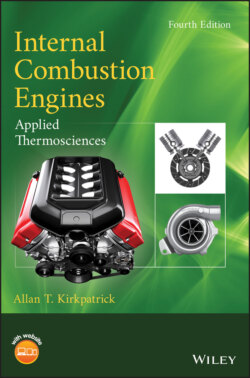Читать книгу Internal Combustion Engines - Allan T. Kirkpatrick - Страница 21
Volumetric Efficiency
ОглавлениеA performance parameter of importance for four‐stroke engines is the volumetric efficiency, . It is defined as the mass of air inducted into the cylinder at bottom dead center divided by the mass that would occupy the cylinder volume at a density of the intake manifold air. The flow restrictions in the intake system, including the throttle, intake port, and valve, create a pressure drop in the inlet flow, which reduces the density and thus the mass of the gas in the cylinder. The volumetric efficiency is thus a mass ratio and not a volume ratio.
The volumetric efficiency for an engine operating at a speed is
(1.19)
The factor of 2 in Equation (1.19) accounts for the two revolutions per cycle in a four‐stroke engine. The ideal gas equation is used to determine the air density in the intake manifold,
(1.20)
The parameter is the ideal gas constant for air with a value of kJ/kg‐K. The intake manifold air density is used as a reference condition instead of the standard atmosphere, so that the effect of a supercharger is not included in the definition of volumetric efficiency. The standard atmosphere is assumed to have a temperature = 298 K and pressure = 101.3 kPa, with a corresponding density = 1.184 kg/.
For two‐stroke cycles, an equivalent volumetric efficiency parameter is the delivery ratio , which is defined in terms of the ambient air density instead of the intake manifold density:
(1.21)
A representative plot of volumetric efficiency versus engine speed of an automotive four‐stroke engine is shown in Figure 1.9. The shape and location of the peaks of the volumetric efficiency curve are very sensitive to the engine speed as well as the manifold configuration. Some configurations produce a flat curve, others produce a very peaked and asymmetric curve. As we will see later, the volumetric efficiency is also influenced by the valve size, valve lift, and valve timing. It is desirable to maximize the volumetric efficiency of an engine since the amount of fuel that can be burned and power produced for a given engine displacement (hence size and weight) is maximized. Although it does not influence in any way the thermal efficiency of the engine, the volumetric efficiency will influence the overall thermal efficiency of the system in which it is installed. As Example 1.1 below indicates, the volumetric efficiency is useful for determination of the air flowrate of an engine of a given displacement and speed.
Figure 1.9 Effect of engine speed and intake manifold geometry on volumetric efficiency. Adapted from Armstrong and Stirrat (1982).
